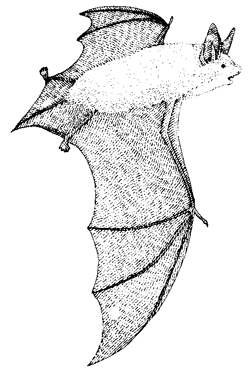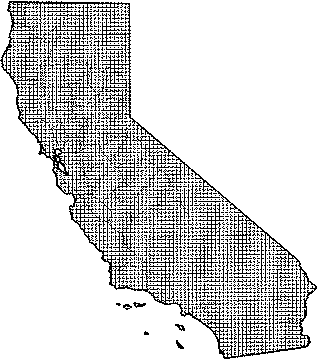
California Myotis
Distribution, Abundance, and Seasonality
The California myotis is a common species found throughout California. It is common to abundant below 1875 m (6000 ft). Optimal habitats for this species include all desert, chaparral, woodland, and forest from sea level up through ponderosa pine, mixed conifer, and Jeffrey pine.

Range Map
Specific Habitat Requirements
Feeding: The California myotis feeds on a variety of aerial arthropods including moths, midges and other Diptera, beetles, and spiders (Krutzsch 1954, Black 1974, Whitaker et al. 1977, 1981). This species forages low over the ground or water, and among shrubs and trees, generally below 4 m (13 ft). Foraging flight is slow and highly maneuverable. The California myotis responds quickly to patches of prey (Bell 1980). Correlated with this ability are short detection-distance and the capacity to make several feeding attempts while passing through a patch of prey (Fenton and Bell 1979).
Cover: This bat may be characterized as a crevice-roosting species. Suitable crevices may be found in buildings, under bark, and in caves and mines. Open spots, especially in human-made structures, are used as night roosts. The California myotis roosts or hibernates in small groups, or singly. This species is less tied to the continual use of particular roosts than are other bats. Individuals appear to use the nearest available night roost after feeding. Transient occupation of roost sites is common, and this species is quick to occupy new sites (Krutzsch 1954, Barbour and Davis 1969, Maser et al. 1981).
Reproduction: Small maternity colonies are found in crevices in buildings, mines, hollow trees, and other sites.
Water: This species has an ability to produce concentrated urine, but it drinks regularly.
Pattern: The California myotis prefers rock-walled canyons with open water, open woodlands and forests, or brushy habitats for foraging.
Species Life History
Activity Patterns: Nocturnal. Hibernates. Emerges early to begin foraging (Vaughan 1954, Jones 1965, Bell 1980). Activity in southern Nevada peaked 1-1.5 hr after sunset (O'Farrell et al. 1967). There may be a second peak before sunrise. This species has been found to be active between 5-33Á C (41-92Á F). Above 15Á C (59` F) it may be active all night, below 15ÁC the activity period is restricted to 4-5 hr (O'Farrell et al. 1967). Activity also is reduced by heavy precipitation or strong winds. The California myotis may be active at any time of year, although activity is greatly reduced in winter. Most individuals hibernate, emerging on warm days to forage (O'Farrell et al. 1967, O'Farrell and Bradley 1970).
Seasonal Movements / Migration: May make local movements to suitable hibernacula.
Home Range: No data found.
Territory: Probably not territorial. Roosts in small groups, or singly.
Reproduction: The California myotis mates in the fall. The young are born from late May-July, with a peak in early June. The single yearly litter averages one young. The young usually are capable of flight by mid-July.
Niche: The California myotis may be found feeding or roosting with other bats. Predators probably include owls, snakes, and small mammals. May carry rabies.
Sources & References
California Department of Fish and Game, 1999.
California's Wildlife, Sacramento, CA.
Written by: J. Harris, reviewed by: P. Brown, edited by: J. Harris, R. Duke
Barbour, R. W., and W. H. Davis. 1969. Bats of America. Univ. of Kentucky Press, Lexington. 286pp. Bell, G. P. 1980. Habitat use and response to patches of prey by desert insectivorous bats. Can. J. Zool. 58:1876-1883. Black, H. L. 1974. A north temperate bat community: structure and prey populations. J. Mammal. 55:138-157. Bond, S. I. 1977. An annotated list of the mammals of San Diego Co., California. Trans San Diego Soc. Nat. Hist. 18:229-248. Bradley, W. G., and J. E. Deacon. 1971. The ecology of small mammals at Saratoga Springs, Death Valley National Monument, California. J. Ariz. Acad. Sci. 6:206-215. Burt, W. H. 1934. The mammals of southern Nevada. Trans. San Diego Soc. Nat. Hist. 7:375-427. Fenton, M. B., and G. P. Bell 1979. Echolocation and feeding behavior in four species of Myotis (Chiroptera). Can. J. Zool. 57:1271-1277. Geluso, K. N. 1978. Urine concentrating ability and renal structure of insectivorous bats. J. Mammal. 59:312-323. Grinnell, J. 1937. Mammals of Death Valley. Proc. Calif. Acad. Sci. 23:115-169. Jones, C. 1965. Ecological distribution and activity records of bats of the Mogollon Mountains area of New Mexico and adjacent Arizona. Tulane Studies Zool. 12:93-100. Krutzsch, P. H. 1954. Notes on the habitats of the bat Myotis californicus. J. Mammal. 35:539-545. Maser, C., B. R. Mate, J. F. Franklin, and C. T. Dyrness. 1981. Natural history of Oregon coast mammals. Pac. Northwest For. And Range Exp. Sta., USDA, For. Serv., Gen. Tech. Rep., PNW-133. 496pp. Miller, A. H., and R. C. Stebbins. 1964. The lives of desert animals in Joshua Tree National Monument. Univ. California Press, Berkeley. 452pp. O'Farrell, M. J., and W. G. Bradley. 1970. Activity patterns of bats over a desert spring. J. Mammal. 51:18-26. O'Farrell, M. J., W. G. Bradley, and G. W. Jones. 1967. Fall and winter bat activity at a desert spring in southern Nevada. Southwest. Nat. 12:163-171. Vaughan, T. A. 1954. Mammals of the San Gabriel Mountains of California. Univ. Kans., Mus. Nat. Hist. Publ. 7:513-582. Whitaker, J. O., Jr., C. Maser, and L. E. Keller. 1977. Food habits of bats of western Oregon. Northwest Sci. 51:46-55. Whitaker, J. O., Jr., C. Maser, and S. P. Cross. 1981. Food habits of eastern Oregon bats, based on stomach and scat analyses. Northwest Sci. 55:281-292.
California Animal Facts | California's Wildlife